OPAL-RING
Y. Tomita Laboratory
Organic photonics, nonlinear photonics, nanophotonics, neutron optics
| Faculty/Department | Department of Engineering Science Graduate School of Informatics and Engineering |
|---|---|
| Members | Yasuo Tomita, Professor |
| Affiliations | Graduate School of Informatics and Engineering Dept. of Engineering Science |
| Website | http://talbot.es.uec.ac.jp/ |
As of August, 2015
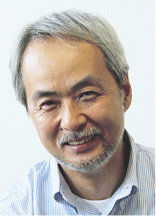
- Yasuo TOMITA
- Keyword
-
Organic photonics, nonlinear photonics, nanophotonics, holographic recording, functional nanocomposite optical material, nonlinear optical material, nanoparticle, photonic crystal,
liquid crystal
Summary of Research
Research and Development of Functional Nanocomposite Materials
for Holographic Applications
I. Introduction
Photonics is generally an optical technology of generation, transmission, detection, control and diversified uses of optical waves. It has been applied to optical communication, information processing, energy, manufacturing, nanotechnology, medicine, and the basic sciences, proving its importance as one of the core technologies in the present information society. During the past 10 years our group has been working on the development of novel nanocomposite photonic materials and their applications such as holographic digital data storage, nonlinear photonic crystals, holographic neutron optical devices. Among these topics we shall describe here novel nanocomposite recording materials for holographic digital data storage.
Conventional optical recording media such as CDs and DVDs record and retrieve information sequentially. That is, recording and readout are performed in such a way that a 1D linear series of bit information (0s or 1s) is recorded as geometrical changes in pit shapes arranged on the 2D plane of the disc surface. On the other hand, twodimensional information (i.e., digital data pages) is recorded as a specific pattern of refractive index distributed in the 3D space by interfering signal and reference beams in a photosernsitive recording medium. Therefore, holographic recording can be done in a parallel and 3D way, resulting in ultra-high density and ultra-fast access as compared to those of the conventional optical disk memory. The concept of holographic memory has been around for more than 40 years. However, its practicability has become clear only in the last two decades because of the advancement of peripheral technologies of compact and efficient semiconductor/solid-state lasers, image sensors, spatial light modulators and recording materials. Among these all-organic photopolymers as holographic recording materials have received much attention as a candidate for WORM (Write-Once Read-Many)-type holographic recording media. However, all-organic photopolymers possess serious problems of polymerization shrinkage and thermal stability by which degradation of stored information takes place. For this reason the development of better holographic recording materials has been of primary interest.
II. Nanoparticle-polymer Composite Materials
We have developed a new holographic recording material for holographic data storage, the so-called photopolymerizable nanoparticle-polymer composite materials (NPCs) in which nanoparticles are uniformly dispersed in photopolymerizable monomer host. By exploiting our new technique, the so-called holographic assembly of nanoparticles in photopolymer, nanoparticles are holographically assembled so that high refractive-index contrast holograms of digital data pages with substantive reduction of shrinkage and high thermal stability can be recorded in NPCs. Our these findings were introduced in Nature magazine and a bulletin of the Materials Research Society (MRS). Also, our results have been shown in numerous invited talks at international conferences and in peer-refereed journals such as Optics Letters, Optics Express, Optical Materials Express and Applied Physics Letters. Furthermore, the
technique of holographic assembly of nanoparticles in photopolymer provides other new applications including nonlinear photonic crystals with semiconductor quantum dots.
Future Prospects
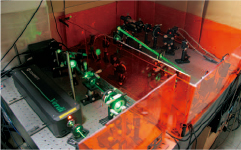
- Optical setup for holographic recording
Currently, we have extended our on-going research topics to quantum beam control; a neutron beam can be controlled by our NPCs via the strong interaction between nucleus of nanoparticles and a neutron beam. This project is an international collaboration with a group headed by Prof. Martin Fally at University of Vienna, Austria. So far, we have successfully achieved mirror (90%), half mirror (1:1) and triple beam splitter (1:1:1) operations. Other possible applications include nanophotonic devices using holographically patterned quantum dots.
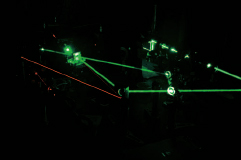
- One scene of our experiment
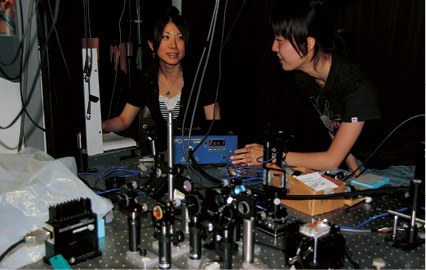
- Graduate students performing an experiment
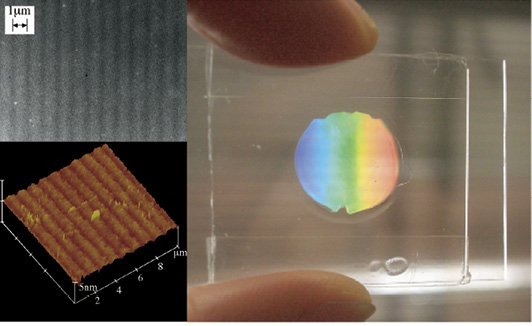
- (Top left) Transmission electron microscope image of a volume hologram recorded in an NPC film (nanoparticle assembly is visible as dark lines)
(Bottom left) Atomic force microscope image of the surface of a volume hologram recorded in an NPC film
(Right) A volume hologram recorded in an NPC film
